Vol. 2, Issue 7 - Jan / Feb 2007
Posted: Thursday 25th January 2007
“Re: your observation (in the last isseue) that after WW2 serious cyclists rode fixed, it is certainally true if by serious you mean racing. However, when I rode with the CTC in the late 40s early 50s the majority of guys, and girls, rode gears albeit often only 3 or 4 speed. Most of them were pretty serious and thought nothing of riding 100+ miles on the Sunday clubrun. Looking back on this era only serves to remind one how the social side of clublife seems largely to have disappeared. In those days there was a clearly defined social season which lasted , roughly, from September until the end of December and most of our members, a diverse lot of RTTC, NCU and BLRC, whilst still “getting the miles in” would of course, indulge in lots of “socialising” some of which cannot be mentioned here!! Anyway, I digress.”
“Regards the ongoing subject of what was and what was not ‘gen’. For us Leaguers, jeans with 4″ turnups (oops – not jeans again!) and check shirts were de rigueur which once promped a rather grumpy NCU official to suggest that we looked like a bunch of Boilermakers assistants!! “Tubs” were carried behind the saddle wrapped in old copies of the ‘Leaguer’ or ‘But et Club’. Another League emblem down here on the coast was to have a HUGE musette made of deckchair material showing the initials BTC (Brighton Town Council, as it was as in those days) p.s. still no news on the Dilecta front. I couldnt have dreamt it, the frame is still hanging up in my tiny garage!!” (Derek was asking for information on his Dilecta)
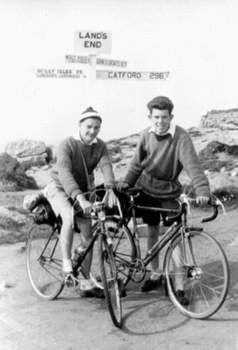
Ed: Derek’s letter is interesting for me as I rode in racing club so only got a one-sided view. It seems unlikely but I cannot remember ever meeting with a CTC tourist on the road but I believe some of the older club officials, most of whom had also cycled pre-war did CTC type touring. Our touring was done with a musette on a stripped down machine, possibly even with tubs. I remember doing short tours with ‘Cane’ sprints and inch-pitch block chain! See Dennis Talbot and Clive Parker below.
The vision of ‘League’ and ‘Union’ riders socialising side by side under the banner of the CTC is an eye-opener as the two sides were at daggers drawn from the top to the bottom of their organisations, the relationship was fuelled by absolute hatred which is so hard to believe looking back from so many years ahead.
Chas Messengers book, Ride and be Dammed gives an insight into this crazy situation which probably put this country light years behind the rest of Europe in the cycling world.
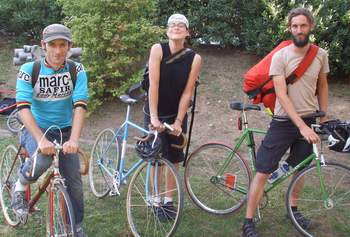
Some owners of classics have a different outlook on life to others. This is the story of three riders in this years L’Eroica event, John is a cycle courier from London. Jacqie works with the London Bicycle Messenger Association and does courier events but is actually employed at Velorution Bike shop in London W1 and Greg is an architect over from Oz. They decided to ride the event using fixed-wheel! See the image below and the captions to get some idea as to what they undertook in Tuscany.
“The real story, however is about the trauma sustained by John’s Gillott when coming over from London and how, when he rode from Pisa to Seina he did so with only 2 chainring bolts and one crank original bolt! In what he likes to call true “vintage style” he had to fake 3 chainring bolts using coke can and the closest sized bolts we could get from the bike shop. Surprisingly, Italian bike shops don’t carry vintage Stronglight components or tools… Ryanair even managed to shatter the shim between the Madison bars and his stem, which he had to replace on the road as well.
There were some exciting moments on the ride.. like when the film crew decided to go ahead of them on a really steep descent and drove so slowly that they had no option but to skid slalom style behind them as John has already lost three spokes in his front wheel so his only brake wasn’t working!!”
(Thanks to Jacquie for the story and to Martin Hanczyc for the image).
Readers of Cambridge Lightweight News 25 will be aware of the challenging terrain for the 75k, 135k and 200k rides in L’Eroica. Patricia and I did the 75k event in 2005 and described it in detail. The event is held in Tuscany where there is no such thing as a level stretch of road, you are either climbing steeply or descending madly. On top of this, in L’Eroica a high percentage of the road is Strada Biancha, i.e. the road surface is broken and gritty and much harder to ride than tarmac. When climbing, especially out of the saddle, it is easy for the rear wheel to spin bringing you to an abrupt stop with little chance of riding away again until you reach a stretch with at least some grip. Descending, the front wheel often has a tendency to head off in some direction of its own compelling you to release the brakes when all you want to do is hang on for dear life.
At the last Ripley Jumble I noticed stacks of fixed-wheel bikes against the fence just inside the gate and I realised that most of them belonged to cycle-couriers who have a cult of fixed riding. I would like to do more myself and plan to try and organise a mid-week fixed ride amongst some friends here in Cambridge.
Clothing.
I often hear clothing talked about at Lightweight Group events so I thought I would recall my impressions of what was really worn in the 40s/50s. I feel there exists a very romanticised idea of dress for this period, I blame Patterson myself. I started club cycling in the late 40s which was a period of extreme austerity when both clothing and food were still rationed. When competing under NCU rules, time-triallists were compelled to ride dressed in black so had to concoct something to wear which fulfilled the rules.
Many riders at this time were youngsters who were serving an apprenticeship and would be taking home something in the region of £1 10s pay. Parents were not such a soft touch in those days so I handed over all my takings bar five shillings although some of the lucky ones kept the whole ten bob! Other riders had probably just left the armed services with nothing much more than a demob suit and a bit of cash which probably all went on the purchase of a shiny new bike. In our club most of the members were apprentices whilst at nearby Wisbech Wheelers many of the young riders worked on the land. Here they were doing men’s work and getting paid as such – probably about £6 per week and up to about £10 in the high season where they did overtime and piece work. They all had proper clothing and very up-to-date equipmemt. A lot of Wisbech Wheelers gear and frames were sold to K L CC members when they were replaced by new.
Most of these apprenticed riders had worn P T kit at school or in the forces consisting of football/PT shorts and a gym shirt not unlike a utility version in Aertex of the current polo shirts. I have asked several riders who I know cycled in those days and they recall that when they couldn’t afford proper cycling gear they wore the PT (now PE) kit, probably dyed black. Our website gallery shows one such rider Ken (apprenticed joiner) in his shorts and shirt stoking a tandem and also in the same gear riding a Middlemarkers event on a solo in the early 50s.
If the weather was too cold for shorts then a pair of cycle-clips were produced and probably worn with the same flannel trousers one had worn for work during the week. A look at the photograph of K D Tubby of Norwich A B C riding a hill-climb in 1952 shows that every one of the many spectators have ordinary trousers with cycle clips (except for the one with his trousers tucked in his socks – cheapskate or what?). It is a fair bet that most of these would have been spectating this event as part of a day out including a club run and their attire is a real representation of what club cyclists were wearing in the 50s. On their tops they have a selection of jumpers and ex-WD clothing (this was heavily advertised in the cycling press). One of them is even wearing what must have been one of the first pairs of the L G hated jeans. Everyone in the shot however has racing style lightweight cycling shoes so these must have been one of the first purchases a cyclist made.
A larger versions of these pictures can be seen on www.classiclightweighs.co.uk in the Photo Gallery. On the right is an image of Dennis Talbot and Clive Parker (both became professional cyclists in the 50s) setting out on a summer’s day run in 1948. Both are on stripped down machines with belongings in a musette. This is how I remember cycling attire in the summer for those lucky enough to own a cycling jersey. Clive Parker aged 18 was working for his uncle, Spanner Rensch and is holding a Paris Galibier he built for himself in the works. Dennis Talbot is still riding and lives near Woburn.
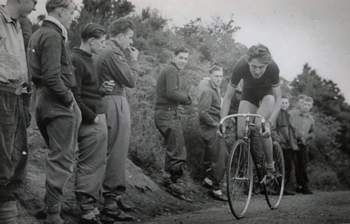
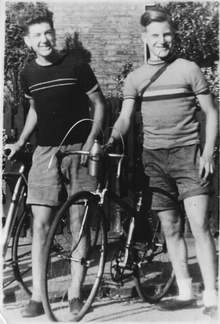
Eventually maybe one acquired a proper cycling jersey with pockets which would be worn all the time. Almost all the cyclists I knew, and there were many, used to wear a cycling jersey or PE style shirt with short shorts for racing, clubruns and touring. One clothing manufacturer pointed out that such products were ideal for this use. Some riders wore their club jerseys all the time whether racing, on club runs or touring. However I have heard that some clubs didn’t allow the official club jerseys to be worn unless racing. One thing that was universal with shorts was ankle socks or no socks at all.
Proper cycling shorts were a luxury to be saved for and in the meantime some riders used to find a school outfitters selling girls’ black gym knickers and then take the elastic out of the legs so they looked like the real thing – or so they hoped! The thought of six-footer cyclists holding a pair of girl’s knickers on their hips to check the size makes the mind boggle.
In winter the chosen fashionable item, if lucky, was a shawl-necked jersey to be worn with the flannels. This garb plus a cape for rain was all one used through cold, rain and snow. Not many could afford the factory made shawl-necked jersey so it was common to get someone in the family to knit one, mother, aunty, grandmother probably and some of these would knit them for friends as well. Some jumpers were made from re-cycled wool, it was common practice to unravel one garment to knit another. As there was no TV at this time most homes had at least one knitter who would sit listening to the radio or even reading a book whilst the needles were going nineteen-to-the-dozen.
Admittedly I moved in racing circles but I guess at least 95% of serious cyclists I knew wore the gear described above. The other 5% were cruelly defined as Tuggos by the racing men.
Although the riders had little money to spend on cycling clobber they certainly didn’t skimp on their ‘irons’. As D K Tubby (NABC) said to me, ‘I wish the pictures were in colour as our team all had Fleur de Lys Gillotts with a flamboyant Majenta mainframe painted over nickel plate. The forks and whole of the rear triangle were chromed. They were always immaculate’. His Gillott is described in detail on the website under British Frame Builders>Gillott>Birth and Life of a 1952 Gillott. Everyone’s machine would be kept in pristine condition with the highest specification affordable as the riders spent every spare penny on them – it was all a matter of pride. When we (Patricia and I) restore machines we like them to look as they would have looked in the hands of a typical 50s club rider, i.e. immaculate, I notice that most members who were actually 50s club riders tend to do the same. I know some enthusiasts consider this to be over-restored, I even heard it said by one collector that he didn’t go to the Reading Ride as the the machines were too clean and shiny whereas I feel that the ride exactly mirrors a 50s clubrun because that is just what it was like.
Cyclists in the 50s had a life outside cycling of course and many had to serve in the armed forces under the two-year conscription scheme. Some were lucky to get posted to camps where the relevent force had a cycling team. Both the army and the R A F had teams which were treated to a lot of time off in order to train and represent their branch in competition. The R A F even went so far as to promote a 5-day stage race in the 50s. Others were not so lucky and a cycling friend of mine, Ken was one of these. He was posted to the war zone of Korea and had to survive in some of the most inhospitable conditions imaginable. To add insult to injury when he was finally sent home to dear old Blighty the clapped-out old steamship he was crossing the Meditteranean in finally gave up the ghost and its engines exploded sending the ship to the bottom. The order was given, “Officers and their wives to the lifeboats – the rest of you over the side”! Ken swam around for about four hours before he was picked up by a passing Norwegian ship.
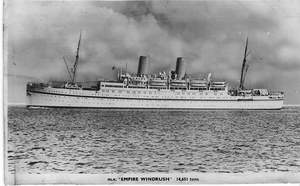
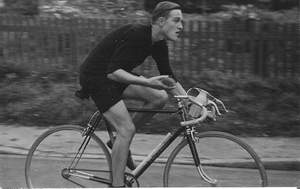
Ken started cycling as a lad in the 40s and still rides regularly with us every week. As a member of West Suffolk Wheelers he regularly time-trialled, most of it on fixed-wheel as did his wife Anne. At one time they both rode Gillott track irons which Ken bought with his savings when he left the army , Ken’s had Fleur de Lys lugs whilst Anne had Nervex Professionals. Unlike many of us V-CC members Ken has cycled regularly throughout his life, as he never took to owning a car, so it was walk or ride and we all know which is best! There are several great images of Ken in action on our website in the Photo Gallery.
Memories of Blackpool Road Club – Part one
Phil Aspinwall (my father) rode with the Blackpool Road Club from 1953 to 1956 and Cleveleys Road Club 1957 to 1959 (interrupted by 2 years National Service). He remembers when he joined, Harry Pilkington was the club champion and that the club was associated with Hall’s Cycle Shop, Church Street, Blackpool, as John Hall was club president. Phil relates that only two members of the club rode gears – Brian Watkiss and Dave Rudd, both of whom were away on National Service in the South of England when he joined the club in 1953. Both riders used Benelux gears but the rest of the club rode fixed. Blackpool RC struggled to compete in team category at events until Dave Rudd returned from National Service as 3 riders were required for a team. Phil states that he remembers only one massed start road race in the Lancashire/Cumbria area at that time, which was the Shap Fell Road Race.
Phil rode the event in 1955 and rode up to the the event and stayed in Hawes Youth Hostel before riding to Tebay for the start of the event. It started somewhere near Tebay on a Sunday and comprised 3 laps of a circuit. Roland Duckett got a fourth but Phil crashed after taking a corner too fast. He managed to avoid hitting a stone wall by riding through an open gate into a field. By the time he had returned to the road the bunch had passed and he was out of the race.
Phil relates that he remembers riding an event in Yorkshire in 1954 but can’t now remember the course. His minute man was a T. Simpson who was a junior 25 mile T.T. champion. It was an out and back course and the theory was Phil should have been able to catch his minute man reasonably quickly but he didn’t catch him until after the turn and then couldn’t drop him! The Blackpool RC won the team event in the 1955 Fylde Combine Championship. The competition attracted riders from Cleveleys RC, Fleetwood RC, Fylde RC, Preston Wheelers, Lancashire RC as well as the Blackpool RC. The winning team was Roland Duckett, Davy Rudd and Phil Aspinwall with an average speed of 23.388mph.
Roland Duckett won the BAR outright, both he and Phil riding fixed gear and Davy Rudd using gears for the 50 and 100 mile time trials. Fixed was the preferred option as riders felt it gave better control especially when riding in a bunch. Living in Blackpool meant riding into a headwind every day so you had to be compact when riding in a group. Phil won a medal for 3rd place in the 1954 Blackpool Road Club 25m T.T.
Championship and won the Cleveleys Road Club Open Hill Climb in 1959 setting a then course record after returning from National Service. He commented that the only training he did was riding to and from work and towing a trailer containing his baby daughter. Phil related he was talked into riding the hill climb and was spitting up blood for a week afterwards. The course was at Littledale north of Lancaster and there were two 1 in 3 corners on it. Phil rode a 58 inch fixed gear and beat Pete Shuttleworth by 10 seconds. His work took him to Manchester shortly after this and commuting between Blackpool and Manchester on a daily basis gave little time to train.
Phil used 3 bikes. The first machine was a fixed wheel Hercules Kestrel which was the ‘hack bike’ used to go to work before his work took him to Manchester. Phil relates that he used to meet up with Stuart Buchanan the Scottish junior 25 mile T.T. Champion on his morning commute out to Squires Gate. They worked different hours so he did not see him in the evening. Phil remembers Stuart as being very quick and a user of gears.
His second machine was a 24 inch Holdsworth Cyclone Roadpath which was ordered via John Hall. It was a custom build, the frame colour being white with dark blue head and seat panel, forty and a quarter inch wheelbase, 23 inch top tube, 74 degree head tube and 73 degree seat tube. This frame had mudguard eyes with clearance for mudguards.
His last machine was a 24 inch Holdsworth Zephyr which was a road bike and fitted with a 4 speed Osgear under the bottom bracket. Frame colour was duck egg blue with black head and seat panel. The frame had no braze-ons except for pump pegs. Phil says this was a cheaper model of frame than the Cyclone and he rode this bike in the Shap Fell road Race in 1955. Bike was fitted with Airlite hubs (can’t remember the rims), GB brakes, GB steel stem and Madison bars (like Maes only deeper). Sprints for time trials were Fiamme rims on Harden hubs or Fiamme rims on Airlite small flange hubs. Spokes were not tied and soldered. Phil also raced on ‘wired ons’ – Michelin 25s on Dunlop Superlite chromed steel rim and Airlite small flange hubs. Sprints were carried in sprint holders either side of the front wheel. Phil had a 1hr 0mins in a 25 mile time trial on wired-ons and Roland Duckett beat the hour riding wired-ons in the same event.
Part Two to follow in the next edition of Lightweight News
Neil Foddering, having read about ‘Tuggos’ sent me the following: “With the reference to the term “Tuggo” in Lightweight News – 6, I thought you might be interested in seeing an original “Helms” cartoon I bought. The main character is “Baz”, who appeared in “Cycling” during the 1950’s.” Helms kindly gave permission for this to be reproduced. Cyclists from the 50s will get the joke!

The website gets responses from many quarters. The following referred to an R O Harrison brochure from a show at the Horticultural show in 1934:
Dear Peter,
I was interested to see on your site the reference to the above relating to an exhibition at the Horticultural Hall in 1934.
I am the present Managing Director and Archivist for the Royal Horticultural Halls in Westminster, London and can confirm that the exhibition to which your brochure relates was the 3rd J.E. Holdsworth Light Weight Cycle Show including Hiking and Camping Equipment held in our then named Old Hall on 27 October to 3 November 1934.
We also hosted other cycling shows for Claud Butler and the primary cycling organisations of the day. Cycling was also a major part of the Schoolboy’s Exhibitions that we hosted from 1926 to the 1960’s.
I have an extensive archive covering the events that have taken place in our Halls since July 1904 when our first Hall on Vincent Square opened. If you are able to send me jpeg images of 300dpi of your brochure, especially the front cover and inside front cover where it may have a reference to us in it, I would be very grateful.
If you would like additional information from me please let me know.
Kind regards,
René Dee – Managing Director – Royal Horticultural Halls & Conference Centre
If anyone has an original copy of the 1934 brochure could they scan the page referring to the Horticultural Hall and send me a copy – Ed.
Just picked out the following ‘clothing’ snippet from an article about Bradford cycle builders which will appear in Lightweight News 8 (March 1st) and 9:- “ The family seemed comfortably off, and Geoff was hauled away on cruises from time to time. He told one fellow cruiser that he’d rather be leaning on the bar of The Spotted House with a pint in his hand than ‘standing here in this monkey suit.’ My mother was horrified. Futher evidence to me of his financial superiority was that he had one of those ‘Continental’ rollneck sweaters, price 5 guineas, from the back page of the Holdsworthy catalogue, whilst I only dreamt.”
Posted: Thursday 25th January 2007
This article appears in the following categories.
Upcoming Events
Whether you are looking for a gentle social meet up, or a 100-mile ride browse the community’s upcoming events and plan your next weekend outing.
